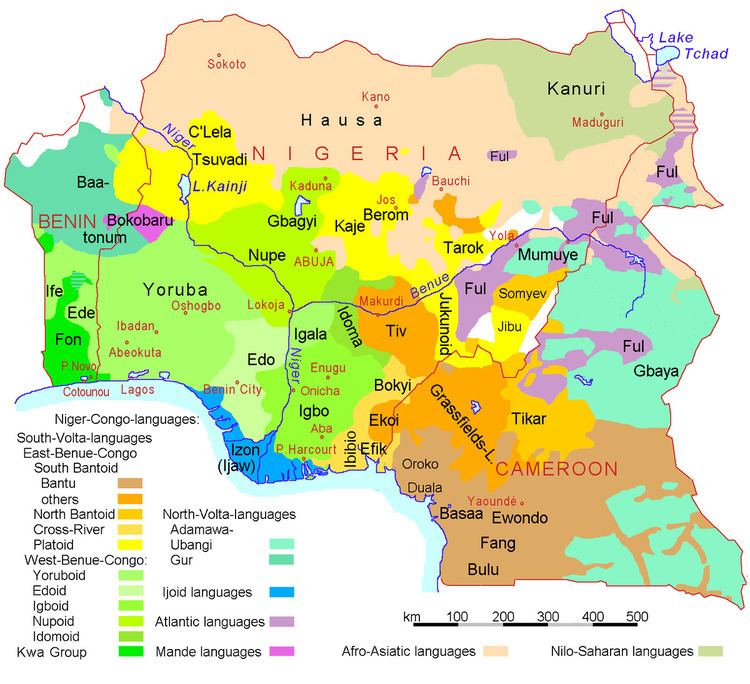 | ||
The Niger–Congo homeland is the area inhabited by speakers of the Niger–Congo languages, which has as its subfamily the Benue–Congo languages, which in turn includes the Bantu languages.
Contents
Origin
The language family probably originated in or near the area where these languages were spoken prior to Bantu expansion (i. e., West Africa or Central Africa) and probably predated the Bantu expansion of c. 3000 BC by many thousands of years. Its expansion may have been associated with the expansion of Sahel agriculture in the African Neolithic period.
According to linguist Roger Blench, as of 2004, all specialists in Niger–Congo languages believe the languages to have a common origin, rather than merely constituting a typological classification, for reasons including their shared noun-class system, their shared verbal extensions and their shared basic lexicon. Similar classifications have been made ever since Diedrich Westermann in 1922. Joseph Greenberg continued that tradition making it the starting point for modern linguistic classification in Africa, with some of his most notable publications going to press starting in the 1960s. But, there has been active debate for many decades over the appropriate subclassifications of the languages in that language family, which is a key tool used in localizing a language's place of origin. No definitive "Proto-Niger–Congo" lexicon or grammar has been developed for the language family as a whole.
An important unresolved issue in determining the time and place where the Niger–Congo languages originated and their range prior to recorded history is this language family's relationship to the Kordofanian languages spoken now spoken in the Nuba mountains of Sudan, which is not contiguous with the remainder of the Niger–Congo language speaking region and is at the northeasternmost extent of the current Niger–Congo linguistic region. The current prevailing linguistic view is that Kordofanian languages are part of the Niger–Congo language family, and that these may be the first of the many languages still spoken in that region to have been spoken in the region. The evidence is insufficient to determine if this outlier group of Niger–Congo language speakers represent a prehistoric range of a Niger–Congo linguistic region that has since contracted as other languages have intruded, or if instead, this represents a group of Niger–Congo language speakers who migrated to the area at some point in prehistory where they were an isolated linguistic community from the beginning.
However, there is more agreement regarding the place of origin of the Benue–Congo subfamily of languages, which is the largest subfamily of the group, and the place of origin of the Bantu languages and the time at which it started to expand is known with great specificity.
The classification of the relatively divergent family of Ubangian languages which are centered in the Central African Republic, as part of the Niger–Congo language family where Greenberg classified them in 1963 and subsequently scholars concurred, was called into question, by linguist Gerrit Dimmendaal in a 2008 article.
Benue–Congo homeland
Roger Blench, relying particularly on prior work by Professor Kay Williamson of the University of Port Harcourt, and the linguist P. De Wolf, who each took the same position, has argued that a Benue–Congo linguistic subfamily of the Niger–Congo language family, which includes the Bantu languages and other related languages and would be the largest branch of Niger–Congo, is an empirically supported grouping which probably originated at the confluence of the Benue and Niger Rivers in central Nigeria. These estimates of the place of origin of the Benue-Congo language family do not fix a date for the start of that expansion other than that it must have been sufficiently prior to the Bantu expansion to allow for the diversification of the languages within this language family that includes Bantu.
Bantu homeland
There is a widespread consensus among linguistic scholars that Bantu languages of the Niger–Congo family have a homeland near the coastal boundary of Nigeria and Cameroon, prior to a rapid expansion from that homeland starting about 3000 BC.
Linguisic, archeological, and genetic evidence also indicates that this expansion included "independent waves of migration of Western African and East African Bantu-speakers into Southern Africa occurred." In some places, genetic evidence suggests that Bantu language expansion was largely a result of substantial population replacement. In other places, Bantu language expansion, like many other languages, has been documented with population genetic evidence to have occurred by means other than complete or predominant population replacement (e.g., via language shift and admixture of incoming and existing populations). For example, one study found this to be the case in Bantu language speakers who are African Pygmies or are in Mozambique, while another population genetic study found this to be the case in the Bantu language speaking Lemba of Zimbabwe.
